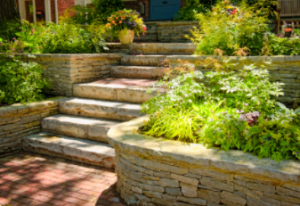A retaining wall is a landscaping structure usually made from concrete, rocks, or any other material to help hold back the earth in front of it. While garden retaining walls are primarily built for practical purposes, they can add significantly to your home’s aesthetic appeal when perfectly incorporated with your existing landscaping design.

Although most people think that these are nothing more than simple walls intended for holding back the ground, the truth is that there are many benefits to implementing the use of this type of landscaping feature. Read on to learn about some of the many benefits of retaining walls and how you can reap as much of them as possible.
They offer a very attractive way to curb traffic into a yard. This is especially true when it comes to large commercial and residential properties. Since most of these structures are made from either concrete or stone, it is very easy to see why they offer such attractive features. Not only do they keep out the elements by providing an attractive backdrop that can easily be added to your existing landscaping, but they also allow for attractive design elements to be integrated into the overall look and feel of the area.
These structures make for good earthquake safety measures. Many buildings make the mistake of not reinforcing the base of their retaining walls. If the wall is built on a concrete slab, it is required by law to reinforce it to withstand strong earth pressures. Even if the wall structure is simply a series of reinforced bricks laid horizontally on the earth’s surface, it is still important to reinforce it to prevent shifting. In addition, since these walls are designed to stay in place and remain intact for a long time, they are also very useful for erosion control. Seismic activity has been known to greatly increase the rate of soil movement, which results in large amounts of erosion and loss of property.
By creating a well-constructed and highly visible feature, such as a retaining wall, homeowners will greatly improve their yard and garden appearance. Unfortunately, the aesthetic value of such a garden feature is often overlooked because many people concentrate instead on the practicality that a well-designed retaining wall offers. In truth, well-designed retaining walls can make an enormous difference in the aesthetics of the area. One of the best ways to achieve this benefit is by carefully selecting the type of material for the wall. The most popular materials for retaining walls include concrete, flagstone, and stone.
Concrete is by far the most common material used for retaining walls Adelaide. It is incredibly easy to maintain, which makes it extremely popular. Because of its versatility, concrete is also a great material for retaining walls built to protect the ground or those placed around a yard to mark the boundaries. One of the most attractive characteristics of concrete is its water resistance. Although concrete does experience some amount of erosion over time, these problems are minimal compared to those experienced by other types of material such as stone.
Flagstone is also another extremely popular option when considering retaining walls Adelaide for gardens and lawn areas. While not particularly unique in terms of form, one of the main selling points of flagstone is its visual appeal. As the name suggests, flagstone adds a degree of aesthetic pleasantness to any flat space. Because flagstone is composed mostly of a hard-wearing natural rock, it is a durable and enduring material that is easy to maintain. It is especially suited to use as a lawn retaining wall due to its resistance to heat and moisture and its ability to provide a level of privacy to its users.